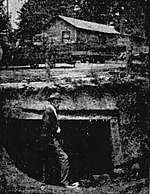Endor Iron Furnace
1861 establishments in North CarolinaBuildings and structures in Lee County, North CarolinaIndustrial buildings and structures on the National Register of Historic Places in North CarolinaIndustrial buildings completed in 1864Ironworks and steel mills in the United States ... and 3 more
National Register of Historic Places in Lee County, North CarolinaProtected areas of Lee County, North CarolinaResearch Triangle region, North Carolina Registered Historic Place stubs
The Endor Iron Furnace was an iron furnace that operated from 1861–1864 and again from 1870–1871, near Cumnock, Lee County, North Carolina. It was constructed between 1862 and 1864 to take advantage of the iron deposits along the Deep River. The furnace is constructed of soft local reddish-gray stones and measures approximately 32 feet square at the base and rises to a height of about 35 feet. During the American Civil War, the furnace produced pig iron for the Confederate Army.It was listed on the National Register of Historic Places in 1974.In 2001, the property was acquired by the Triangle Land Conservancy.
Excerpt from the Wikipedia article Endor Iron Furnace (License: CC BY-SA 3.0, Authors).Endor Iron Furnace
Iron Furnace Road, Sanford
Geographical coordinates (GPS) Address Nearby Places Show on map
Geographical coordinates (GPS)
| Latitude | Longitude |
|---|---|
| N 35.550175 ° | E -79.224472222222 ° |
Address
Iron Furnace Road
27330 Sanford
North Carolina, United States
Open on Google Maps



